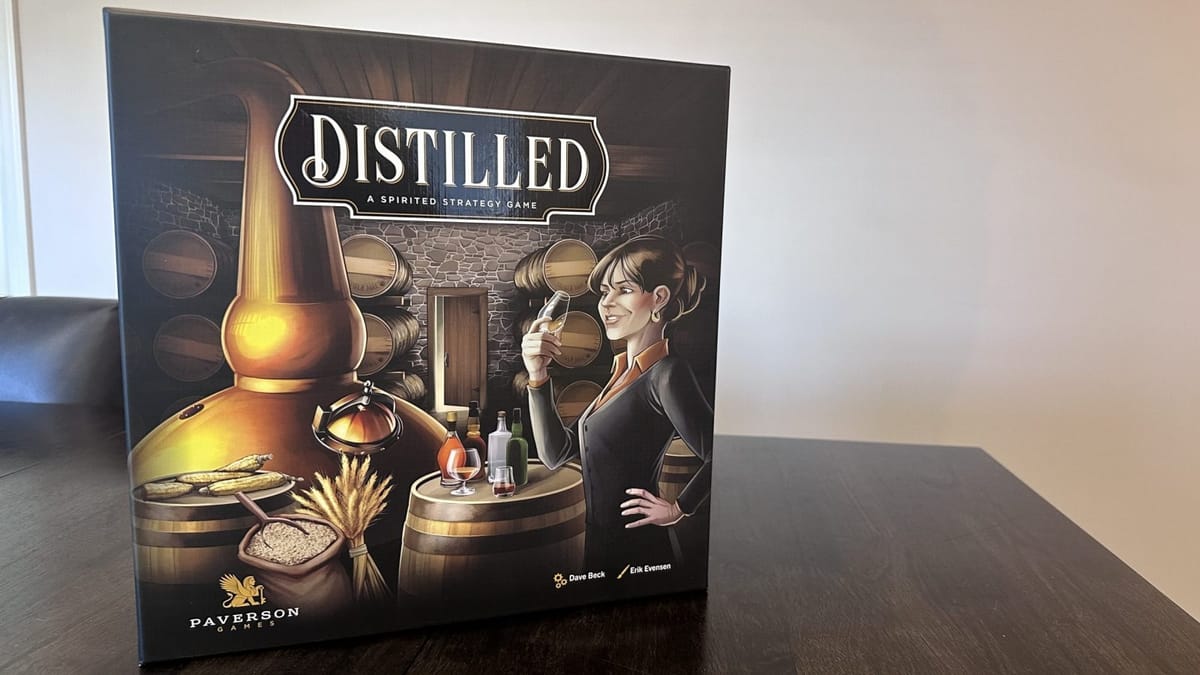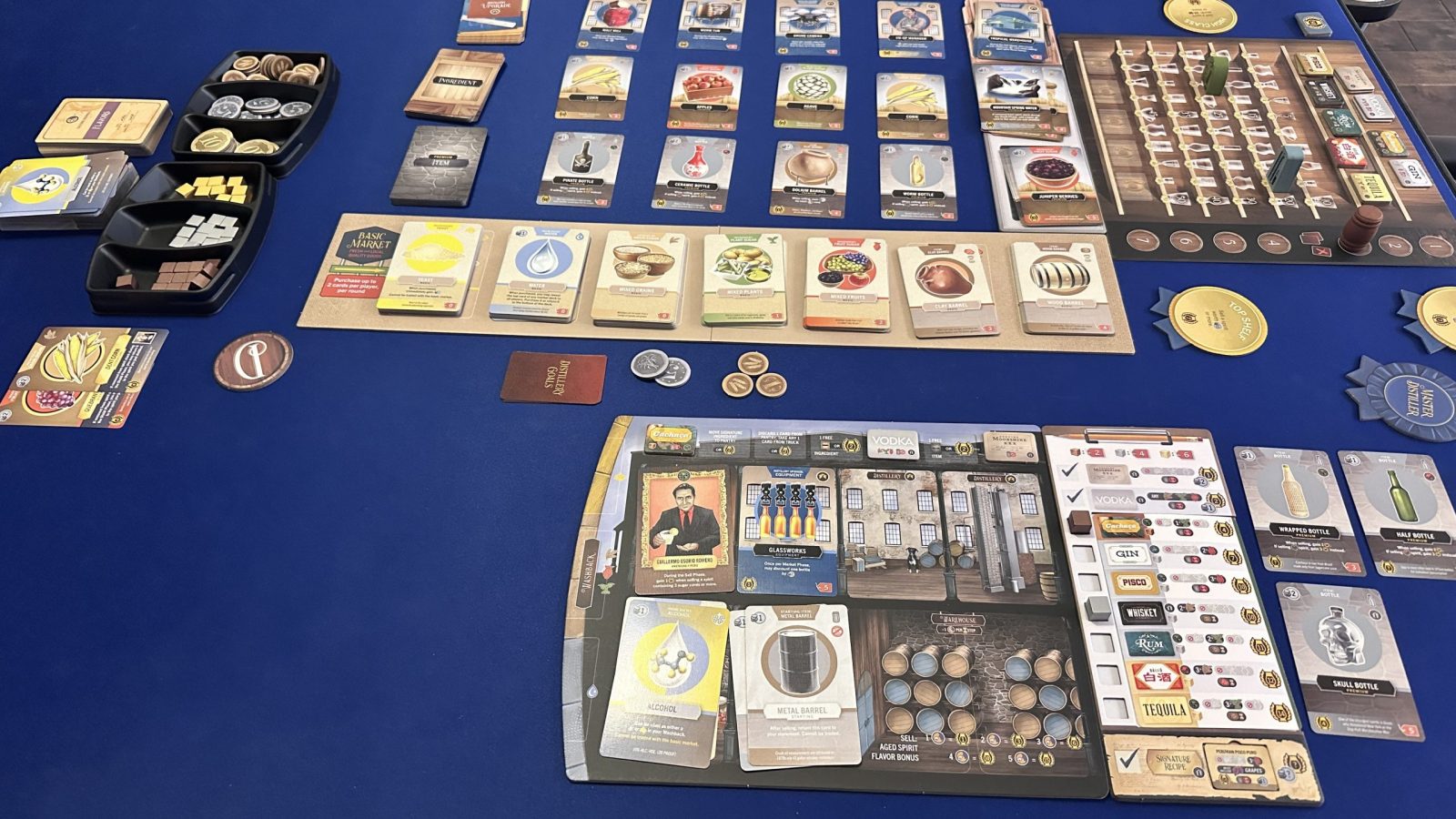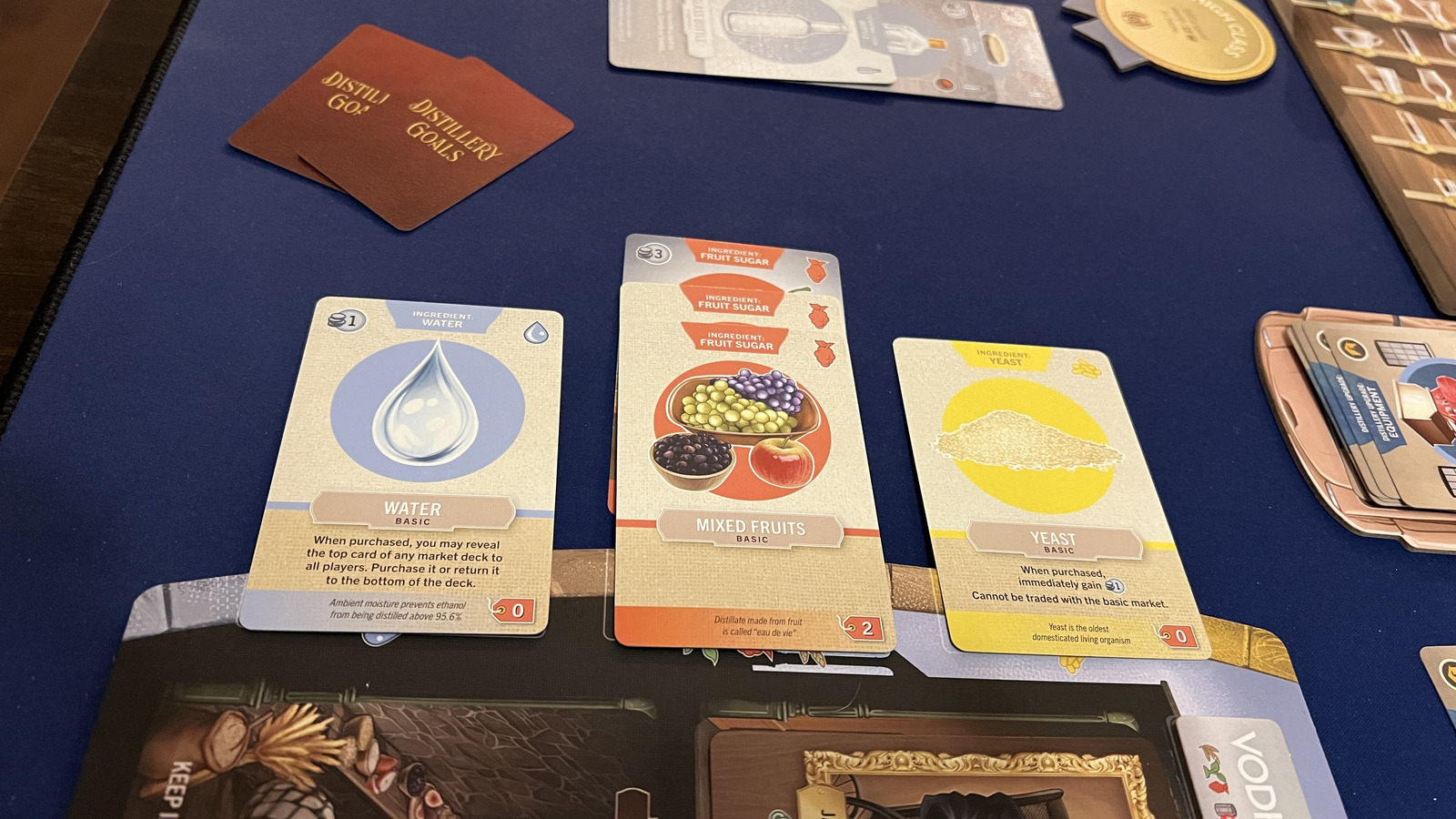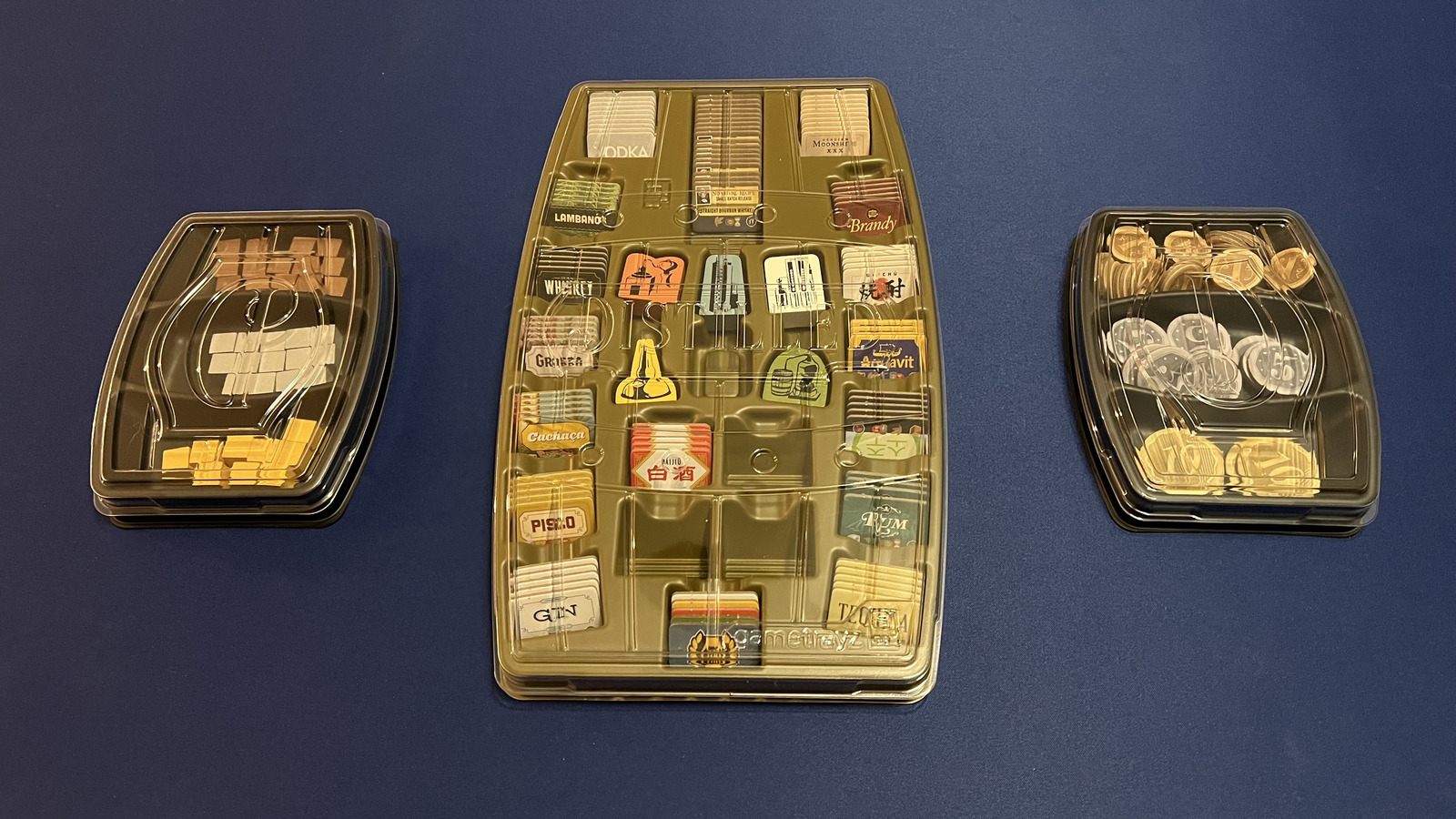
Living in Tennessee and being a big fan of bourbon, how could I resist the chance to review Distilled (2023) from Paverson Games? This highly detailed strategic card game promises to take you through the journey of revitalizing an abandoned distillery passed down to you as inheritance and to make your mark in becoming the Master Distiller.
The base game plays 1-5 players and I found no major differences in gameplay between the various player counts – only a matter of additional time per player. Game setup is pretty straightforward with a main market in the center of the table with two areas: a basic market and a Premium market. The basic market has items and ingredients while the premium market has Distillery Upgrades, Premium Ingredients, and Items.
From there, each player will set up their player board which represents their distillery as well as select their distiller identity card, which will define their signature spirit and provide some in-game asynchronous abilities. The player board also contains your recipe card and victory points for selling each spirit once it’s been crafted. Now it’s time to get this distillery operating!
HOW TO PLAY
The game is played over just 7 rounds, while each round consists of four phases: Market, Distilling, Selling and Aging with some cleanup occurring within those phases. During the market phase, the players will take turns buying 2 items at most from the basic market and as many items as they can afford from the premium market until all players have passed. Each player board will show the various recipes available to be distilled. You start with the knowledge to make vodka and moonshine – what you buy in the market will determine the spirits you can craft.

A player board in the foreground, with the Premium and Basic Market in the background. Score tracking on the right and resources along the left side.
The items in the basic market will provide you with cards that represent the equipment and ingredients you need to make a spirit. However, buying only basic cards will provide no potential bonus points or additional money in the sell phase – so it’s a good strategy to also pick up some premium ingredients, equipment or distillery upgrades from the premium market as well each round if you’re able to afford them. Additionally, you can learn new recipes and get new employees to boost your abilities. It is important to make sure you have water, yeast and sugars in order to be able to distill a spirit in the next step so keep an eye on your board for the cards you have available. Finally, some spirits require specific barrels as well – so keep an eye on what your recipes require for you to be able to distill and sell the spirit.
During the distilling phase, you will use the ingredients that you have purchased to put into your washback – creating a deck of cards that symbolizes all of the ingredients you are using in hopes of distilling the spirits available to you. Keep in mind that no matter what, you will always distill Moonshine and be able to sell it with the basic equipment and ingredients that you have on hand with your starting materials and cards. Once you’ve put your water, sugars and yeast into the washback, you will shuffle the deck and then pull the top and bottom card of the deck out of the washback and put them back in your pantry. This represents the “heads and tails” of the washback that you lose during the distilling process. You’ll then reveal the ingredients remaining to use towards making your spirit for the round. The only thing you MUST still have in the washback is the required sugar(s) for a recipe you have access to make.
This brings the table to the Sell Phase – which is coupled with the Aging Phase. If you have a spirit eligible to be aged, you would choose to put it in your cellar instead of selling it immediately. Or you may choose to sell a spirit you aged on a previous turn. Either way, players will take turns selling the spirits they have that either were just made or are in their cellars. One at a time, each player will sell until all have passed, gaining victory points and money for the spirit, ingredients and equipment used to craft and sell it. Here is where you may use speciality bottles, barrels and finer ingredients in your washback to improve your yield.
Finally the aging phase will allow you to take those spirits that require aging and put them into your cellar in a particular type of barrel, then add flavor cards that will make that spirit worth more victory points once you decide to sell it. The longer you age it, the more flavor cards it gains and exponentially more victory points once you sell or at the end game where all aged spirits are sold for their victory point total. All spirits in your cellar will get new flavor cards each round they remain there.
The last thing to highlight here is that after distilling and before selling you will take the specified label for the spirit you have crafted if that label is still available. These are populated, for the most part, with 1 label of each type per player in the game. This label will go along the top of your player board and will unlock your choice of 7 different bonuses which will help boost your capabilities throughout the game.
With the round complete, you’ll move the round marker and get ready to move into the next market phase. At the end of the market round, you’d have removed the oldest (farthest right) card in the market for each row in the premium market and refilled with new cards. Keep repeating this process until seven rounds have been played.
STRATEGY
So the above recap is pretty basic, as there is significant depth of strategy in this game and I’ll do my best to delve into it here. With each player getting a Distiller Identity to start the game, every player will have a different path to victory as each signature spirit will have a different ingredient, barrell and aging requirement Having played it a few times, I would find it very tough to win without getting your signature spirit distilled at some point during the game. It is worth more victory points than the normal recipes, and the premium ingredients it requires will also boost the money earned by selling it. In effect, you’re building an engine throughout the game to make the distilling process efficient enough to guarantee your distilling of your signature spirit goes off without a hitch.
Through various upgrades to your equipment, staff and ingredients you legitimately build up your distillery to be capable of better, more sought after and more expensive spirits. Additionally, there is a strategic element to building your washback with extra sugars, water and yeast to make as dense of a washback as possible, thus minimizing the chance that you pull out a needed ingredient during the removal of the heads and tails.
Finally, the aging process for certain spirits gives you some very real time decisions to make on when to pull your product out of the warehouse and sell it, versus leaving it there to continue to get flavor cards added to improve the final outcome. The more flavor cards, the more victory points it will be worth at the end of the game. Any spirits not sold in the last round will still be evaluated for their victory point total at the end of the game.
There are so many levels to this game, with additional points for personal objectives and competitive Spirit Awards that will give bonus victory points for those achievements.
COMPONENTS
The retail version of this game comes with fantastic components. Having played both this version and a friend’s Kickstarter version that has some minor upgrades to components, I can say that I’m very satisfied with the retail-level components and the Game Trayz storage solutions are always a welcome bonus. The cards are all canvas print finish, the player boards are sturdy with excellent thematic artwork and the sideboard is double layered. I’m a huge proponent of double layered boards when you have components that need to be stored there to prevent being bumped, and these are perfect.
RULEBOOK
The game designers did an excellent job writing this rulebook – and for those picking up a game like this for the first time, there is a separate simplified rulebook to get you started as well. The rulebook is littered with explanations on how the mechanics of the game reflect the real life processes involved with distilling. It is very detailed without getting too bogged down with technical jargon. It’s very easy to follow and reference when there is a rules question.
Distilled
Excellent
Distilled is a decently heavy euro with a ton of interconnected parts that make you always plan a few steps ahead, while trying to optimize your current turn. Churning through the various options of spirits to craft, the equipment to improve your distillery, the people to hire and the various ingredients that you will need to make your washback will keep your brain busy. Choices abound - so will you make the right ones to make sure you become the Master Distiller?
Pros
- Complex Yet Approachable - There are a lot of complex decisions to make but really any level of gamer can engage.
- Theme - Very well thought out, uses the real distilling process and equipment.
- Design - Overall game design is high quality, art is fantastic and great components with storage inserts.
Cons
- Set Up - Very component heavy, need space and patience to get this game set up.
- Victory Point Track - The player pieces provided are too big for the spots on the track.
- Repetitive - Market & Distilling phases can feel repetitive without that big satisfying move while progressing through the game.


